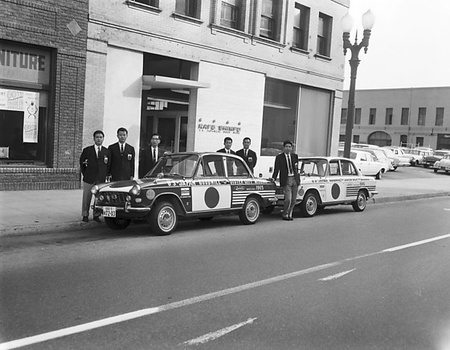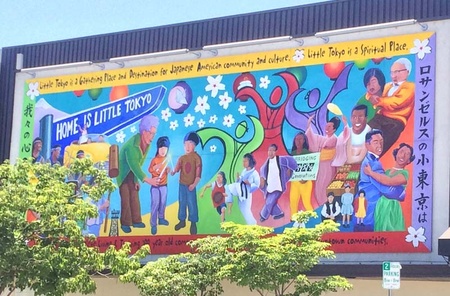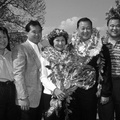This year, 2014, Little Tokyo is celebrating its 130th anniversary. Which is remarkable, since it has constantly been threatened with abandonment and extinction since World War II. In fact, twenty-two years ago, I thought Little Tokyo was dying. But in each case, a common remedy allowed the historic Nikkei neighborhood in downtown Los Angeles to overcome seemingly overwhelming obstacles: an unwillingness to give up and an ability by community members to work together. It is even feasible that the current supporters of Little Tokyo may be able to choose a path for the Southern California historic cultural center for Japanese Americans instead of just reacting to events and other people’s projects.
To be clear, my earlier pessimism was a fair assessment. Many of the elements that had invigorated the Little Tokyo of my youth and young adulthood had dissipated or even disappeared. By the early 1990s, petty crime appeared to run rampant, especially if you dared to park your car on the street or in an unattended parking lot. After the upheaval following the first Rodney King trial in 1992, where even the nearby Los Angeles Police Department parking lot was overrun and the Los Angeles Times building had its windows smashed, many people refused to visit Little Tokyo after dark. Local businesses began closing early and there was often a deserted quality to J-Town after dark that felt like death.
Things looked bleak. It wasn’t just that Little Tokyo had changed from the days when I first started working at The Rafu Shimpo in the 1970s, but the rest of the world as well. During its peak years before and after World War II, Little Tokyo provided the essential services all ethnic communities need: restaurants and markets that provided Nikkei food not readily obtainable in the suburbs; Japanese-speaking professionals; community Buddhist temples and Christian churches; and, products from Japan not sold elsewhere in America.

U.S.-Japan Goodwill Sister City Mission automobiles in front of Rafu Shimpo, January 1, 1966. Photograph by Toyo Miyatake Studio, Gift of the Alan Miyatake Family, Japanese American National Museum. [96.267.883]
In those days, if you needed tofu or kamaboko or even shoyu, where would you go to buy them? Not at Alpha Beta or Ralph’s. It had to be a Japanese market and there were at least five or six Nikkei markets in Little Tokyo. What if you wanted to eat sushi? Well, it was only in the 1960s when Kawafuku restaurant in Little Tokyo opened America’s first sushi bar at the urging of Noritoshi Kanai of Mutual Trading. In fact, landmark Little Tokyo restaurants such as Horikawa, Tokyo Kaikan, and A Thousand Cranes set a basic standard for Nikkei cuisine. While Japanese electronic products are ubiquitous today, you could not find them at department stores like the Broadway or May Company. People at the time falsely labored under the impression that anything “Made in Japan” was cheap and poorly constructed. I remember buying my first Panasonic AM/FM cassette player/recorder at the Ginza Gift store in Little Tokyo. I only replaced it when I bought my first stereo when I was in college.

Mutual Trading Company building, August 20, 1968. Photograph by Toyo Miyatake Studio, Gift of the Alan Miyatake Family, Japanese American National Museum [96.267.1021]
What changed was that items like Japanese food and electronics were co-opted into the mainstream. Sushi became popular in the 1980s and 1990s to the point you could find a sushi bar in any random strip mall. Mainstream supermarkets began selling Japanese rice and tofu and American electronic stores proudly displayed Sony and Panasonic stereos and televisions. Sony founder Akio Morita’s idea for the Walkman changed how the world listened to music and consumers looked to Japan for new innovations. Soon there would be Japanese VCRs and CD players and smaller and smaller televisions everywhere.
On one hand, it was great that Japan’s image was changing and on the other it was sad for Little Tokyo, which had lost a part of its unique appeal. No longer one of the main sources for Nikkei essentials, people only made the trip to Little Tokyo occasionally or not at all. Interestingly, the next group of new customers for Little Tokyo was the growing number of tourists from a prospering Japan. Sensing an opportunity, Japanese businesses created support services in the area for this group. The most prominent new business was the New Otani Hotel and Gardens facility, built on the site of the old Sun Building. Japanese tourists who were interested in visiting Hollywood or Disneyland preferred to stay in a hotel where the employees spoke Japanese and served Japanese food. Tourists from Japan began arriving by the busload and businesses that catered to this single customer base jumped into fray without a lot of thought for the local Nikkei community.
Japanese tourism eventually moved beyond Southern California and the West Coast to Las Vegas, New York, and Florida and places like Niagara Falls and the Grand Canyon. They began skipping Little Tokyo entirely, which led to the sad state of the early 1990s that culminated with the riotous aftermath of the first Rodney King trials in 1992. My own hopes for Little Tokyo’s future reached a new low.
What saved Little Tokyo in this case is the same thing that saved it from the Great Depression, World War II, and redevelopment: people who cared. People who cared about Little Tokyo responded to the Great Depression by founding Nisei Week; to the forced removal during the war by returning to rebuild their community after their release from the concentration camps; and to city redevelopment by fighting to preserve its historic remnants. In the 1980s and 1990s, they responded by organizing volunteer patrols of the area to fight petty crime and by banding together to promote the interests of their community when the economic situation looked weakest.
A group of local merchants organized under the late Dr. Linda Morimoto to form the Greater Little Tokyo Anti-Crime Association. After years of implementing volunteer patrols, this group evolved into the Little Tokyo Public Safety Association (LTPSA). Under the leadership of Brian Kito (Fugetsu-Do) and Satoru Uyeda (S.K. Uyeda Store), it fulfilled Dr. Morimoto’s dream of opening a Japanese-style koban or police substation in 1996. Sadly, Dr. Morimoto, who had delivered thousands of babies in her career, was murdered in a burglary that same year before the dedication of the koban, which also operates as an information center today.
Other groups such as the Little Tokyo Business Association (LTBA), led by the late Frances Hashimoto, successfully engaged the City of Los Angeles to create the Little Tokyo Business Improvement District (BID). Tax monies through the city are directed to the BID for marketing, beautification, and security of the neighborhood.
The most significant new development, in my opinion, was the formation of the Little Tokyo Community Council (LTCC), which brought together the local non-profit organizations, religious institutions, businesses, residents, and other concerned individuals in 2000. LTCC created an entity capable of interacting with government agencies, while providing a monthly public forum to bring up issues and highlight activities. When the City of Los Angeles proposed constructing a new headquarters and jail for its police department in the open space near the Nishi Hongwanji Buddhist Temple, LTCC and other groups were able to voice their concerns in a unified manner that changed the direction of the project. This issue reminded long-time supporters of Little Tokyo of the construction of the Parker Center headquarters of LAPD that essentially removed an entire block of Little Tokyo in the 1950s, but with an entirely different outcome.
Speaking of history, the Little Tokyo Service Center (LTSC) and its then-executive director Bill Watanabe spent much time and effort to preserve the essential character of Little Tokyo beginning in the 1990s. Bill in particular spearheaded community gatherings to seek input on how to keep Little Tokyo from disappearing in the manner of so many other ethnic enclaves. Bill consulted with outside groups like the Los Angeles Conservancy, but found no other precedent for successfully keeping historic ethnic enclaves viable. Indeed, the great majority of Japanese American districts had either vanished or shrunken to distressing levels. Los Angeles’s Little Tokyo, San Jose’s Japantown, and San Francisco’s Nihonmachi were seen as the last bastions of historic Nikkei areas, and all three were facing the same uncertain future.
Once again, the response was for people who cared to work together. When Sumitomo Bank divested itself of all its bank branches in California, it provided a grant through its Sumitomo Global Foundation in 1998 to create a new organization called the California Japanese American Community Leadership Council (CJACLC). The CJACLC, composed of representatives from throughout the state, decided to originate a project, “Preserving California’s Japantowns”, whose goal was to document the history of all the California Japanese American neighborhoods, both big and small. The project created a wonderful website at www.californiajapantowns.org that includes fascinating stories and historic photographs that help to keep alive the spirit of the many J-Towns no longer in existence.
Little Tokyo suffered immensely when the world changed in the 1970s and some of its unique offerings were co-opted. Today, fate seems to be balancing the scales, as Little Tokyo has become a destination for young people of all backgrounds for fun places to eat and hangout. The steady incursion of new housing with apartment buildings carrying Japanese names like Mura, Hikari, and Sakura rising like weeds in and around Little Tokyo has provided a new population base for the area. But despite the Japanese monikers, the Nikkei population has not risen appreciably, which leads to some nervousness by traditionalists, who fear more dissipation of the historical-cultural elements of the neighborhood.
Couple that with the massive Metro Regional Connector project, which will run a subway train directly under Little Tokyo to link places like Long Beach, Culver City, Pasadena, and East Los Angeles, major change is on the horizon. The Regional Connector project as first proposed by Metro represented the worst case scenario for Little Tokyo. Not only were the trains set to run at street level, which would have permanently disrupted traffic, there was no plan for a full station, which would allow Little Tokyo to reap the benefits of mass transit. As with the proposed LAPD headquarters and jail, LTCC, LTBA, and other concerned individuals made their feelings known at public hearings and private meetings. A timely letter from the late U.S. Senator Daniel Inouye, who was then Chairman of the Senate’s Appropriations Committee, got Metro’s attention, and major adjustments were brought about to help deal with mitigating the long construction process as well as having the trains run underground with a station that is expected to be one of the busiest in the system. Metro’s response has been mostly positive and provided hope that it was possible to work cooperatively with government agencies to achieve beneficial outcomes.
Which brings us to today. The notion that Little Tokyo could actually plan its future rather than just react to current events helped to drive the latest project called Sustainable Little Tokyo. Its goal is “to establish the community’s vision for sustainable transit-oriented development around the 1st/Central Regional Connector station that furthers and enhances Little Tokyo’s cultural and historic assets.” Thanks to the efforts of LTSC in partnership with LTCC and grant funding from organizations like the Natural Resources Defense Council and Enterprise Community Partners, among others, Sustainable Little Tokyo has already had a series of public focus group meetings to gather community input. The result of this work is available at the Little Tokyo Community Council website. The project wants to provide community-based criteria for new developments in and around Little Tokyo, including around the Regional Connector station at First and Central, the parking lot north of the Japanese American National Museum, and the Mangrove site east of the current Gold Line station at First and Alameda.
So am I optimistic? As optimistic as a Japanese American who is aware of our community’s long history can be. Like the Jewish community saying, “Hope for the best, expect the worst,” I can never feel hope without reservation. But Sustainable Little Tokyo may be the best opportunity to plan for the future as opposed to enduring it. Anyone who cares about Little Tokyo should jump in now. Working together is our greatest strength.
© 2014 Chris Komai






